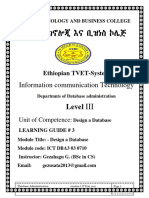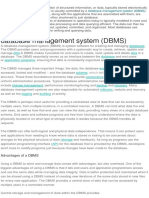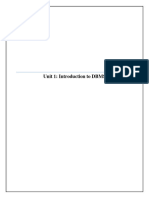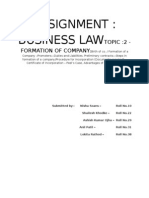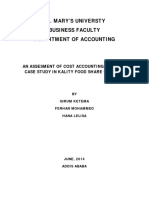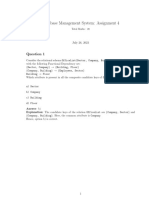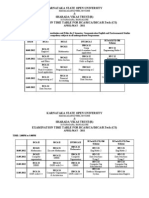Data Redundancy and Inconsistency
Uploaded by
balainsaiData Redundancy and Inconsistency
Uploaded by
balainsaiINTRODUCTION
A database is a collection of data elements (facts) stored in a computer in such a
systematic way that a computer program can consult it to answer questions. The answers
to those questions become information that can be used to make decisions that may not be
made with the data elements alone. The computer program used to manage and query a
database is known as a database management system (DBMS).
A database is a collection of related data that we can use for
Defining (specifying types of data)
Constructing (storing & populating)
Manipulating (querying, updating, reporting)
A Database Management System (DBMS) is a software package to facilitate the
creation and maintenance of a computerized database. A Database System (DB) is a DBMS
together with the data.
Features of a database
It is a persistent (stored) collection of related data.
The data is input (stored) only once.
The data is organized (in some fashion).
The data is accessible and can be queried (effectively and efficiently).
FILE SYSTEMS VERSUS DATABASE SYSTEMS
DBMS are expensive to create in terms of software, hardware, and time invested.
Why should we use them? Why couldn’t we just keep all our data in files, and use
word-processors to edit the files appropriately to insert, delete, or update data? And we
could write our own programs to query the data! This solution is called maintaining data in
flat files. However, flat files have the following limitations.
• Uncontrolled redundancy
• Inconsistent data
• Inflexibility
• Limited data sharing
• Poor enforcement of standards
• Low programmer productivity
• Excessive program maintenance
• Excessive data maintenance
Drawbacks of file systems :
Drawbacks of using file systems to store data are:
Data redundancy and inconsistency
Due to availability of multiple file formats, storage in files may cause
duplication of information in different files.
Difficulty in accessing data
In order to retrieve, access and use stored data, we need to write a new
program to carry out-each new task
Data isolation
To isolate data we need to store them in multiple files and different
Formats.
Integrity problems
Integrity constraints (e.g. account balance > 0) become part of program
code which has to be written every time. It is hard to add new constraints or
to change existing ones.
Atomicity of updates
Failures of files may leave database in an inconsistent state with partial
updates carried out
E.g. transfer of funds from one account to another should happen either
completely or Partially.
oncurrent access by multiple users
Concurrent access of files is needed for better performance and it is also true
that Uncontrolled concurrent accesses of files can lead to inconsistencies
E.g. two people reading a balance and updating it at the same time
Several Security related problems caused in file system.
Database Management System Approach
The Data maintained in the form of DBMS has the following advantages
Controlled redundancy
o consistency of data & integrity constraints
Integration of data
o self-contained & represents semantics of application
Data and operation sharing
o multiple interfaces
Services & Controls
o security & privacy controls
o backup & recovery
o enforcement of standards
Flexibility
o data independence
o data accessibility
o reduced program maintenance
Ease of application and development
Limitations of Database Management System
Database Management System is
more expensive
more complex
general
simple
stringent real-time
single user
static
Levels of Abstraction
Physical level : It is also known as internal schema which describes data
storage structures and access paths. It typically uses a physical data
model and the details are hidden from database users. It describes how a
record (e.g. customer) is stored.
Logical level: It is also known as conceptual schema which describes the
structure and constraints for the whole database. It uses a conceptual or
implementation model. It describes data stored in database, and the
relationships among the data.
type customer = record
street : string;
city : integer;
end;
View level: It is also known as External schema, whichdescribes various
user views. Usually uses the same data model as conceptual level. As
shown in Fig 1.1 , Different views may have different interpretations of
the same data item. Application programs hide details of data types.
Views can also hide information (e.g. salary) for security purposes.
Diagram for Levels of Data abstraction
You might also like
- Department of Software Engineering DBMS: Unit OneNo ratings yetDepartment of Software Engineering DBMS: Unit One26 pages
- COMP 214 DATABASE SYSTEMS NOTES PDF Sem 1 2019 PDF50% (2)COMP 214 DATABASE SYSTEMS NOTES PDF Sem 1 2019 PDF47 pages
- Introduction To Database Management System-NotesNo ratings yetIntroduction To Database Management System-Notes46 pages
- 1.1. Introduction To Macroeconomics: Chapter OneNo ratings yet1.1. Introduction To Macroeconomics: Chapter One118 pages
- Accounting Assignment P4-5A: Anya's Cleaning Service0% (1)Accounting Assignment P4-5A: Anya's Cleaning Service10 pages
- Meaning of Standard Cost and Standard CostingNo ratings yetMeaning of Standard Cost and Standard Costing33 pages
- Effect of e Taxation On Revenue Generation in Nigeria A Pre Postanalysiss 1528 2686 26 3 3551No ratings yetEffect of e Taxation On Revenue Generation in Nigeria A Pre Postanalysiss 1528 2686 26 3 355119 pages
- Introduction To File and Database SystemsNo ratings yetIntroduction To File and Database Systems26 pages
- Assignment - 1: Information Systems and Digital FirmsNo ratings yetAssignment - 1: Information Systems and Digital Firms12 pages
- MODULE 1: Systems Development and Documentation Techniques System Documentation TechniquesNo ratings yetMODULE 1: Systems Development and Documentation Techniques System Documentation Techniques4 pages
- Chapter-2: The Accounting Cycle: Accounting For A Service Enterprise 2.1No ratings yetChapter-2: The Accounting Cycle: Accounting For A Service Enterprise 2.119 pages
- BSB61015 Advanced Diploma of Leadership and Management: BSBMKG605 Evaluate International Marketing OpportunitiesNo ratings yetBSB61015 Advanced Diploma of Leadership and Management: BSBMKG605 Evaluate International Marketing Opportunities14 pages
- Chapter One: 1.1. Back Ground of The Study100% (1)Chapter One: 1.1. Back Ground of The Study31 pages
- Jimma University College of Business and Economics Department of Accounting100% (1)Jimma University College of Business and Economics Department of Accounting14 pages
- Chapter 1 - Introduction To Database SystemNo ratings yetChapter 1 - Introduction To Database System27 pages
- Fundamental of Accounting I Assigment IINo ratings yetFundamental of Accounting I Assigment II6 pages
- A Database Management System (DBMS) Is A Software Package Designed To Define, Manipulate, Retrieve and Manage Data in A DatabaseNo ratings yetA Database Management System (DBMS) Is A Software Package Designed To Define, Manipulate, Retrieve and Manage Data in A Database8 pages
- TCP - Part I: Relates To Lab 5. First Module On TCP Which Covers Packet FormatNo ratings yetTCP - Part I: Relates To Lab 5. First Module On TCP Which Covers Packet Format31 pages
- CS8492-Database Management Systems Department of CSE: Relational DatabasesNo ratings yetCS8492-Database Management Systems Department of CSE: Relational Databases18 pages
- Data Independence Is The Type of Data Transparency That Matters For A Centralised DBMS. ItNo ratings yetData Independence Is The Type of Data Transparency That Matters For A Centralised DBMS. It5 pages
- HCI - Nov-Dec 2017 Anna University Question Paper - Part ANo ratings yetHCI - Nov-Dec 2017 Anna University Question Paper - Part A1 page
- Designing Enterprise Architecture Based On TOGAF 9.1 FrameworkNo ratings yetDesigning Enterprise Architecture Based On TOGAF 9.1 Framework12 pages
- Argtable Is An ANSI C Library For Parsing GNU Style Command Line Options With A Minimum of Fuss. It Enables A Program's Command Line Syntax To Be Defined in The Source Code As An Array of ArgtableNo ratings yetArgtable Is An ANSI C Library For Parsing GNU Style Command Line Options With A Minimum of Fuss. It Enables A Program's Command Line Syntax To Be Defined in The Source Code As An Array of Argtable17 pages
- ArcGis - Portal Setup - TW - 2038-97 PDFNo ratings yetArcGis - Portal Setup - TW - 2038-97 PDF61 pages
- Process Chain Email Alert Monitoring - Prem - (Sap BW Powered Hana)No ratings yetProcess Chain Email Alert Monitoring - Prem - (Sap BW Powered Hana)1 page
- Programmatic Approach Using DATA Step and PROC SQL Creating A SAS Data Set Using DATA StepNo ratings yetProgrammatic Approach Using DATA Step and PROC SQL Creating A SAS Data Set Using DATA Step11 pages
- Expand Your Beaglebone Black Micro SD Card Space100% (2)Expand Your Beaglebone Black Micro SD Card Space5 pages
- AWS Account: Virtual Private Cloud (VPC)No ratings yetAWS Account: Virtual Private Cloud (VPC)3 pages
- Downloads Time Table April 2012 BCA MCA IMCA (1) FinalNo ratings yetDownloads Time Table April 2012 BCA MCA IMCA (1) Final10 pages
- Diploma Iii Year (Computer Science and Engineering) : 2012-2013 SubjectsNo ratings yetDiploma Iii Year (Computer Science and Engineering) : 2012-2013 Subjects1 page
- Replication of Company Code Data From CRM To ECCNo ratings yetReplication of Company Code Data From CRM To ECC9 pages
- 27.2.12 Lab - Interpret HTTP and DNS Data To Isolate Threat Actor100% (1)27.2.12 Lab - Interpret HTTP and DNS Data To Isolate Threat Actor9 pages
- GUIDE BarracudaWebApplicationFirewall PDFNo ratings yetGUIDE BarracudaWebApplicationFirewall PDF358 pages
- TSW SOAP Interface Technical Notes For DotNET Client v0 4No ratings yetTSW SOAP Interface Technical Notes For DotNET Client v0 423 pages
- COMP 214 DATABASE SYSTEMS NOTES PDF Sem 1 2019 PDFCOMP 214 DATABASE SYSTEMS NOTES PDF Sem 1 2019 PDF
- Accounting Assignment P4-5A: Anya's Cleaning ServiceAccounting Assignment P4-5A: Anya's Cleaning Service
- Effect of e Taxation On Revenue Generation in Nigeria A Pre Postanalysiss 1528 2686 26 3 3551Effect of e Taxation On Revenue Generation in Nigeria A Pre Postanalysiss 1528 2686 26 3 3551
- Assignment - 1: Information Systems and Digital FirmsAssignment - 1: Information Systems and Digital Firms
- MODULE 1: Systems Development and Documentation Techniques System Documentation TechniquesMODULE 1: Systems Development and Documentation Techniques System Documentation Techniques
- Chapter-2: The Accounting Cycle: Accounting For A Service Enterprise 2.1Chapter-2: The Accounting Cycle: Accounting For A Service Enterprise 2.1
- BSB61015 Advanced Diploma of Leadership and Management: BSBMKG605 Evaluate International Marketing OpportunitiesBSB61015 Advanced Diploma of Leadership and Management: BSBMKG605 Evaluate International Marketing Opportunities
- Jimma University College of Business and Economics Department of AccountingJimma University College of Business and Economics Department of Accounting
- A Database Management System (DBMS) Is A Software Package Designed To Define, Manipulate, Retrieve and Manage Data in A DatabaseA Database Management System (DBMS) Is A Software Package Designed To Define, Manipulate, Retrieve and Manage Data in A Database
- TCP - Part I: Relates To Lab 5. First Module On TCP Which Covers Packet FormatTCP - Part I: Relates To Lab 5. First Module On TCP Which Covers Packet Format
- CS8492-Database Management Systems Department of CSE: Relational DatabasesCS8492-Database Management Systems Department of CSE: Relational Databases
- Data Independence Is The Type of Data Transparency That Matters For A Centralised DBMS. ItData Independence Is The Type of Data Transparency That Matters For A Centralised DBMS. It
- HCI - Nov-Dec 2017 Anna University Question Paper - Part AHCI - Nov-Dec 2017 Anna University Question Paper - Part A
- Designing Enterprise Architecture Based On TOGAF 9.1 FrameworkDesigning Enterprise Architecture Based On TOGAF 9.1 Framework
- Argtable Is An ANSI C Library For Parsing GNU Style Command Line Options With A Minimum of Fuss. It Enables A Program's Command Line Syntax To Be Defined in The Source Code As An Array of ArgtableArgtable Is An ANSI C Library For Parsing GNU Style Command Line Options With A Minimum of Fuss. It Enables A Program's Command Line Syntax To Be Defined in The Source Code As An Array of Argtable
- Process Chain Email Alert Monitoring - Prem - (Sap BW Powered Hana)Process Chain Email Alert Monitoring - Prem - (Sap BW Powered Hana)
- Programmatic Approach Using DATA Step and PROC SQL Creating A SAS Data Set Using DATA StepProgrammatic Approach Using DATA Step and PROC SQL Creating A SAS Data Set Using DATA Step
- Downloads Time Table April 2012 BCA MCA IMCA (1) FinalDownloads Time Table April 2012 BCA MCA IMCA (1) Final
- Diploma Iii Year (Computer Science and Engineering) : 2012-2013 SubjectsDiploma Iii Year (Computer Science and Engineering) : 2012-2013 Subjects
- 27.2.12 Lab - Interpret HTTP and DNS Data To Isolate Threat Actor27.2.12 Lab - Interpret HTTP and DNS Data To Isolate Threat Actor
- TSW SOAP Interface Technical Notes For DotNET Client v0 4TSW SOAP Interface Technical Notes For DotNET Client v0 4






